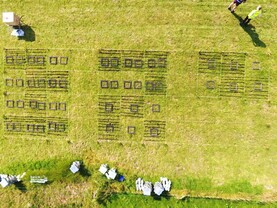Farmers’ expectations on carbon farming diversifying their incomes must be managed to avoid over-selling its benefits while ignoring potential pitfalls, a Teagasc conference on carbon counting heard last Thursday.
Work is under way at EU and national levels to develop a framework around carbon farming, with methods of monitoring and verifying the on-farm removal of carbon from the atmosphere. This would then pave the way for private industry to pay farmers to do so.
The conference heard that not all soils have the ability to store large quantities of carbon and the carbon that is sequestered must be held permanently, while uncertainties remain on the amount of carbon removed.
Expectations should be managed while a watertight system of verifying removals is developed, warned Bernard Harris, an inspector with the Department of Agriculture’s climate and bioenergy division.
Risks
“The first one I am going to put here is certainly overarching – managing expectations. What do people expect will come from this?
“We are being continually told that it is a diverse income source and that comes with its own risks,” stated Harris.
“There will be cases where there will be winners and losers in this.”
The Department official indicated that a policy statement on carbon farming will be “published shortly” outlining the key principles around establishing a framework.
An implementation plan will follow on from this which will test methodologies, large-scale rollout of measures.
Only 53% of farmers, foresters and landowners who took part in a consultation on the framework said that they would be willing to sign up to a carbon farming initiative.
This is a figure which Harris claimed “shows the uncertainty in this space”.
Harris pointed out that cost efficiency will play a role in determining which on-farm actions prove themselves worth implementing on the ground for payment.
Some actions may not return enough funding to justify their reporting and verification costs, he explained to the conference attendees. “If it is going to cost too much – the monitoring, reporting and verification activity on the ground – then those activities might not be funded or rewarded at the end of the day,” he explained.
The conference also heard from Bernie Duffy, project officer of the FarmPEAT project, on the Environmental Protection Agency’s emissions estimate for drained peats halving this year from the carbon dioxide equivalent of four family cars per hectare to two cars.
Karl Richards , the head of Teagasc’s climate research centre, suggested that knowledge gaps on exact emissions and sequestration counting, such as that on peat soil emissions, should make farmers wary when attempting to estimate any future carbon farming income from their land.
“If a farmer had received payment last year when there was [the carbon emissions equivalent of]four cars.
“This year it is [the equivalent of] two cars, so would that farmer now have to pay money back?” Richards said.
However, he suggested that although accurate figures for each measure taken may not be known yet, they could still be used as estimates while further work is undertaken to determine their real impact and payment potential.






 This is a subscriber-only article
This is a subscriber-only article









SHARING OPTIONS: